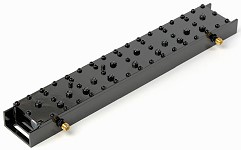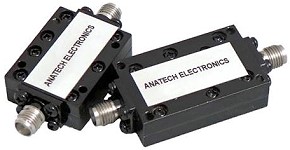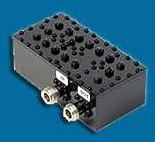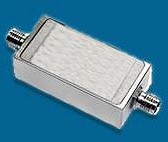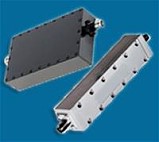Anatech Electronics March 2024 Newsletter |
||

Press Release Archives: 2024 | 2023 | 2022 | 2021 |2020 2019 | 2018 | 2017 | 2016 | 2015 2014 | 2013 | 2012 | 2011 | 2010 2009 | 2008 | 2007 | 2006 | 2005 Content is copyright of company represented. Page format, custom text and images are RF Cafe copyright - do not distribute.
Sam Benzacar of Anatech Electronics, an RF and microwave filter company, has published his March 2024 newsletter that, along with timely news items, features his short op−ed entitled "5G Broadcast is Finally Coming," where he reports on the progress recently made in fulfilling plans finalized in the 2017 in 3GPP Release 14. "In a nutshell, 5G Broadcast makes it possible to deliver high-bandwidth content to a massive audience concurrently without compromising network performance." The whole 5G scheme is to have the capacity to completely replace wired communications with wireless. That involves two-way data transfers in the Gbps realm. My cable Internet connection is providing a download speed of 590 Mbps and upload of 25 Mbps (upload speeds are severely throttled for some reason), per SpeedTest.net. Using a cellphone as a mobile hotspot, I get around 22 Mbps down and 12 Mbps up. Those numbers are dependent upon when you happen to measure it, but I know they are typical of what I see. That represents a wired connection 22x faster than wireless, but then my Galaxy S7 is not the best platform to measure wireless performance. Finally, with 5G, people can watch an 8K UHD feature length movie on their phones while sitting in the stands at a ball game or in a movie theater. A Word from Sam Benzacar - 5G Broadcast is Finally Coming
Even though "5G broadcast" was standardized in 2017 in 3GPP Release 14, nothing much has come of it, but this appears likely to change soon as it gives carriers the ability to provide targeted advertising and content to users based on their preferences and location, an enormous potential new revenue stream. It also makes it possible to stream multimedia content such as high-definition videos and virtual reality, even in places where hundreds or thousands of people are using their phones or other devices at the same time. In a nutshell, 5G Broadcast makes it possible to deliver high-bandwidth content to a massive audience concurrently without compromising network performance. Its transmission model departs from the conventional "unicast" model that streams data to individual users, instead using a one-to-many model, transmitting content simultaneously to many devices. As the standard transmission model isn't designed for this, it would result in spectrum congestion and unacceptable performance. 5G Broadcast can operate in either spectrum used by over-the-air TV stations, or the frequencies used by cellular services. The concept has been tried before, but it never took off, as MediaFLO, LTE Broadcast, and DVB-H were never widely accepted. Verizon, a big proponent of LTE Broadcast, ended its go90 streaming video service in 2018.
5G Broadcast relies on Single-Cell Point-to-Multipoint (SC-PTM) transmission, which optimizes signal distribution to any device that can receive 5G Broadcast. As it doesn't usually require an active SIM card, it can be used by devices without a cellular subscription. 5G Broadcast won't be available in the next year or so because device manufacturers will need to integrate 5G Broadcast capability into their products, and network operators will have to upgrade their infrastructure. A likely timeframe is sometime in 2025 or 2026, although first responders may get it sooner. FCC Ups "Acceptable" Broadband Speeds
Tiny Transmitter Tracks Hummingbirds In Real-Time
CTIA Says Cable Industry Fighting Fixed Wireless Access
Groups Say Tesla Can Be Hacked
Anatech Electronics Introduces a New Line of Suspended Stripline and Waveguide Type RF Filters
Check out Our Filter Products
Cavity Band Pass Filters LC Band Pass Filters Cavity Bandstop/Notch Filter About Anatech Electronics Anatech Electronics, Inc. (AEI) specializes in the design and manufacture of standard and custom RF and microwave filters and other passive components and subsystems employed in commercial, industrial, and aerospace and applications. Products are available from an operating frequency range of 10 kHz to 30 GHz and include cavity, ceramic, crystal, LC, and surface acoustic wave (SAW), as well as power combiners/dividers, duplexers and diplexers, directional couplers, terminations, attenuators, circulators, EMI filters, and lightning arrestors. The company's custom products and capabilities are available at www.anatechelectronics.com. Contact: Anatech Electronics, Inc.
Posted March 23, 2024 |
||

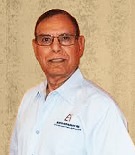 By Sam Benzacar
By Sam Benzacar However, this time may be the charm because, unlike earlier attempts, it doesn't
rely on wireless carriers to be its sole providers. Media companies or broadcasters
can operate their own networks independent of a wireless operator using existing
broadcast towers and UHF broadcast spectrum. Over-the-air TV has been making a comeback
of late thanks to the rollout of ATSC 3.0, which essentially defines OTA TV as we
know it by combining over-the-air signals with broadband.
However, this time may be the charm because, unlike earlier attempts, it doesn't
rely on wireless carriers to be its sole providers. Media companies or broadcasters
can operate their own networks independent of a wireless operator using existing
broadcast towers and UHF broadcast spectrum. Over-the-air TV has been making a comeback
of late thanks to the rollout of ATSC 3.0, which essentially defines OTA TV as we
know it by combining over-the-air signals with broadband.  The FCC has increased
its official definition of minimum acceptable broadband data rates to 100 Mb/s upstream
and 20 Mb/s downstream rather than 25 Mb/s and 3 Mb/s, which it defined as acceptable
in 2015. During the usual debates that occur when the FCC makes decisions, this
one was contested. Providers offering fiber to the home (FTTH) that is inherently
symmetrical stated that "an asymmetrical standard implies that entertainment use
is more important than productivity uses that require more upload bandwidth." That,
in turn, was contested by the Wireless Internet Service Providers Association (WISPA),
which primarily serves rural areas, and Starlink, which said the FCC definition
was fine, not surprising as neither offers symmetrical data rates.
The FCC has increased
its official definition of minimum acceptable broadband data rates to 100 Mb/s upstream
and 20 Mb/s downstream rather than 25 Mb/s and 3 Mb/s, which it defined as acceptable
in 2015. During the usual debates that occur when the FCC makes decisions, this
one was contested. Providers offering fiber to the home (FTTH) that is inherently
symmetrical stated that "an asymmetrical standard implies that entertainment use
is more important than productivity uses that require more upload bandwidth." That,
in turn, was contested by the Wireless Internet Service Providers Association (WISPA),
which primarily serves rural areas, and Starlink, which said the FCC definition
was fine, not surprising as neither offers symmetrical data rates. 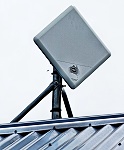 Wireless industry trade
association CTIA claims the cable industry is lobbying against the allocation of
5G spectrum in an attempt to slow the adoption of fixed wireless access, which is
primarily offered by the three major wireless carriers as a replacement for cable
and fiber. "For more than 40 years, cable benefited from local government policies
that shielded them from competition," noted the CTIA. "But today, they face a competitive
threat in the form of 5G home broadband. They noted that 5G has captured more than
95% of new broadband additions over the past two years, and about 20% of new 5G
FWA subscriptions are new to broadband. "Cable's reaction to a significant loss
in market share is to cut off access to the raw material that would supercharge
competition—dedicated licensed spectrum," the CTIA concluded.
Wireless industry trade
association CTIA claims the cable industry is lobbying against the allocation of
5G spectrum in an attempt to slow the adoption of fixed wireless access, which is
primarily offered by the three major wireless carriers as a replacement for cable
and fiber. "For more than 40 years, cable benefited from local government policies
that shielded them from competition," noted the CTIA. "But today, they face a competitive
threat in the form of 5G home broadband. They noted that 5G has captured more than
95% of new broadband additions over the past two years, and about 20% of new 5G
FWA subscriptions are new to broadband. "Cable's reaction to a significant loss
in market share is to cut off access to the raw material that would supercharge
competition—dedicated licensed spectrum," the CTIA concluded.  Researchers
Researchers